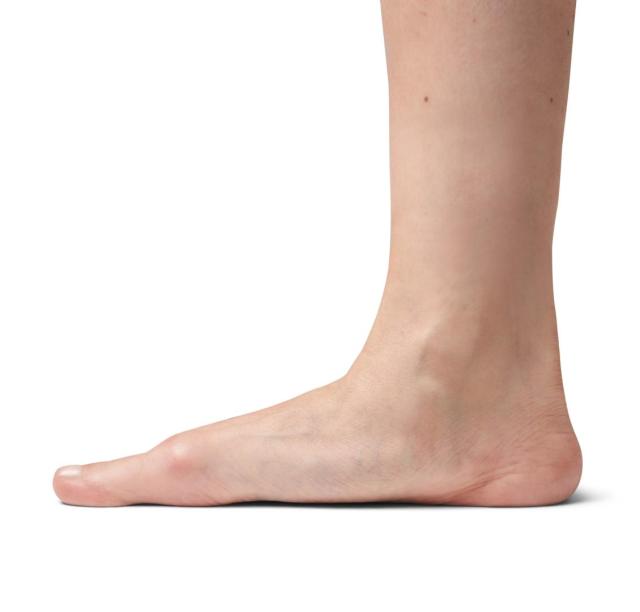Heel pain
Heel pain can be extremely painful. The heel is the first thing that hits the ground when you take a step. The heel bone is also the largest bone in the foot, so it is made to withstand this load.
How heel pain occurs?
Pain in the heel usually occurs when your feet are overloaded for a long time. It is important to find out the cause of the pain so that you can get the right treatment. Do not put up with heel pain for too long - it will not go away on its own. If you have the pain for too long then you may change the way you walk and get pain elsewhere.
Flat feet
In many cases, the cause of pain in your heel is that you are flatfooted. The pain is due to the tendon, whose job is to lift your the arch up, being irritated, sore or in some cases inflamed due to being overloaded.
Heel spur
Sometimes it can also be that the pain is associated with a heel spur. A heel spur is a bone formation that occurs after prolonged overload and thereby an irritation where the tendons attach to the heel bone. A heel spur is a consequence of being overloaded over time.
Heel pain
Heel pain can also be a symptom of other diseases, but is very often a clear indication of overload or that your footwear is not appropriate. If you often have pain in your heels, it is a good idea to consider whether you walk too much on too hard a surface, or whether you have misalignments in your feet, such as flat feet or hollow feet.
The forefoot and heels become heavily strained when we move or stand up for many hours at a time, and many therefore experience developing heel pain. If you have pain in your heels, you should look at, among other things, your footwear and your activity pattern. Be sure to react - although of course you may have heel pain for a single day, without it meaning that you are developing, for example, heel spurs. However, if you generally start to suffer from heel pain, you are wise to react quickly.

Heel pain and pregnant?
As a pregnant woman, you may experience pain in your feet because they swell. Also, the ligaments that hold the bones in the feet in place may become loose during a pregnancy. This is because you form a special hormone that loosens the ligaments in the birth canal and pelvis, which can also affect the ligaments of your feet. It can lead to overpronation, which can cause pain and discomfort. Some pregnant women also suffer from hard skin and cracked heels, which can also be painful. Here it is important that you choose some good footwear.
Treatment of heel pain
Most often, heel pain is caused by some form of overload. If you start to get a sore heel, the first thing is to stay calm for a few days and also to consider how you can prevent the pain from getting worse.
Your footwear naturally plays a big role in relation to how stressed your feet become, and therefore you should look at whether your shoes, for example, give you the necessary support and are sufficiently shock-absorbing. Remember that the footwear you wear the most during the day must be good.
What footwear is good if I have heel pain?
- It should be long enough and wide enough.
- Optimal shock absorption inside the footwear in the form of an insole, so your foot bone is well protected.
- High stability in the form of a stable heel cap and a built-in shank in the outsole - it provides a better and steadier gait.
- Effective closing system that holds your foot firmly in place.
Insoles
There are many different types of insoles that can relieve your heels and give your footwear better shock absorption. If you are flatfooted or hollow-footed there is a greater risk of getting problems with your feet, and in such a case, you may benefit from an insole.
Ready-made insoles will help many people really well, but sometimes it is not enough and there will be a need for a custom insole made especially for you, so you will get support exactly where your feet need it.
> Read more about our Korrektor® insole here
> Read more about our shock-absorbing Protektor® insoles here
What can I do to prevent heel pain?
Although a lot of heel pain is due to incorrect or too much exercise, in fact, you can get rid of heel with training. A good exercise for heel pain is a heel lift, which is performed like this:
- Stand on a step or similar.
- Place the toes of one foot on the edge of the step so that most of your foot extends over the edge.
- Take 3 seconds to lift yourself up on your toes and hold the position for 2 seconds.
- Take 3 seconds to lower yourself down again.
- Repeat 12 times on each foot.
Have you been diagnosed with a disease?
If you have been diagnosed with a disease that requires special footwear or insoles, it is important that you listen to your practitioner's advice. Experimenting on your own can have serious consequences. We and our resellers are happy to advise, but it is your practitioner who has access to your medical history and so the practitioner's advice is very important.